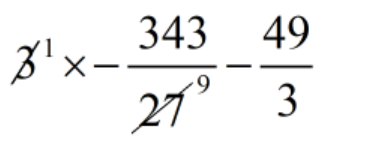NCERT Solutions Class 9 Maths Chapter 2 Polynomials Exercise 2.3
Introduction:
In this exercise/article we will learn about Polynomials. Remainder theorem, is it not a simple way to find the remainder obtained on dividing a polynomial by a linear polynomial? We will now generalise this fact in the form of the following theorem. We will also show you why the theorem is true, by giving you a proof of the theorem.
NCERT Class 9 Maths Chapter 2 Polynomials :
- NCERT Class 9 Maths Chapter 2 Polynomials Exercise 2.1
- NCERT Class 9 Maths Chapter 2 Polynomials Exercise 2.2
- NCERT Class 9 Maths Chapter 2 Polynomials Exercise 2.3
- NCERT Class 9 Maths Chapter 2 Polynomials Exercise 2.4
- NCERT Class 9 Maths Chapter 2 Polynomials Exercise 2.5
- Extra Questions Class 9 Maths Chapter 2 Polynomials
Class 9 Maths Exercise 2.3 (Page-40)
Q1. Find the remainder when x3 + 3x2 + 3x + 1 is divided by
(i) x + 1
Solution :
Let p(x) = x3 + 3x2 + 3x + 1
So, x + 1 = 0
x = - 1
Using remainder theorem,
when p(x) = x3 + 3x2 + 3x + 1
than p ( - 1 ) = ( - 1 )3 + 3( - 1 )2 + 3 × - 1 + 1
= - 1 + 3 × 1 - 3 + 1
= - 1 + 3 - 3 + 1 [ because - 1 + 1 = 0 and 3 - 3 = 0 ]
= 0
So, remainder = 0.
(ii) x - \(\displaystyle \frac{1}{2}\)
Solution :
Let p(x) = x3 + 3x2 + 3x + 1
So, x - \(\displaystyle \frac{1}{2}\) = 0
x = \(\displaystyle \frac{1}{2}\)
Using remainder theorem,
When p(x) = x3 + 3x2 + 3x + 1
than p( \(\displaystyle \frac{1}{2}\) ) = ( \(\displaystyle \frac{1}{2}\) )3 + 3( \(\displaystyle \frac{1}{2}\) )2 + 3 × \(\displaystyle \frac{1}{2}\) + 1
= \(\displaystyle \frac{1}{8}\) + 3 × \(\displaystyle \frac{1}{4}\) + \(\displaystyle \frac{3}{2}\) + 1
= \(\displaystyle \frac{1}{8}\) + \(\displaystyle \frac{3}{4}\) + \(\displaystyle \frac{3}{2}\) + 1
= \(\displaystyle \frac{{1\,+\,6\,+\,12\,+\,8}}{8}\)
= \(\displaystyle \frac{{27}}{8}\)
So, remainder = \(\displaystyle \frac{{27}}{8}\) .
(iii) x
Solution :
Let p(x) = x3 + 3x2 + 3x + 1
So, x = 0
x = 0
Using remainder theorem,
when p(x) = x3 + 3x2 + 3x + 1
than p( 0 ) = ( 0 )3 + 3( 0 )2 + 3 × 0 + 1
= ( 0 )3 + 3 × ( 0 )2 + 0 + 1
= 0 + 3 × 0 + 1
= 0 × 0 + 1
= 1
So, remainder = 1 .
(iv) x + \(\displaystyle \pi \)
Solution :
Let p(x) = x3 + 3x2 + 3x + 1
So, x + \(\displaystyle \pi \) = 0
x = - \(\displaystyle \pi \)
Using remainder theorem,
when p(x) = x3 + 3x2 + 3x + 1
than p( - \(\displaystyle \pi \) ) = ( - \(\displaystyle \pi \) )3 + 3( - \(\displaystyle \pi \) )2 + 3 × - \(\displaystyle \pi \) + 1
= - \(\displaystyle \pi \)3 + 3 × \(\displaystyle \pi \)2 - 3\(\displaystyle \pi \) + 1
= - \(\displaystyle \pi \)3 + 3 - \(\displaystyle \pi \)2 - 3\(\displaystyle \pi \) + 1
So, remainder = - \(\displaystyle \pi \)3 + 3 - \(\displaystyle \pi \)2 - 3\(\displaystyle \pi \) + 1
(v) 5 + 2x
Solution :
Let p(x) = x3 + 3x2 + 3x + 1
So, 5 + 2x = 0
x = \(\displaystyle -\,\frac{5}{2}\)
Using remainder theorem,
when p(x) = x3 + 3x2 + 3x + 1
than p( \(\displaystyle -\,\frac{5}{2}\) ) = ( \(\displaystyle -\,\frac{5}{2}\) )3 + 3(\(\displaystyle -\,\frac{5}{2}\) )2 + 3 × \(\displaystyle -\,\frac{5}{2}\) + 1
= \(\displaystyle -\,\frac{{125}}{8}\,+\,3\,\times \,\frac{{25}}{4}\,-\,\frac{{15}}{2}\,+\,1\)
= \(\displaystyle -\,\frac{{125}}{8}\,+\,\frac{{75}}{4}\,-\,\frac{{15}}{2}\,+\,1\)
= \(\displaystyle \frac{{-\,125\,+\,150\,-\,60\,+\,8}}{8}\)
= \(\displaystyle \frac{{-\,185\,+\,158}}{8}\)
= \(\displaystyle -\,\frac{{27}}{8}\)
So, remainder = \(\displaystyle -\,\frac{{27}}{8}\) .
NCERT Solutions Class 9 Maths
Q2. Find the remainder when x3 - ax2 + 6x - a is divided by x - a .
Solution :
Let p(x) = x3 - ax2 + 6x - a
So, x - a = 0
= x = a
Using remainder theorem,
when p(x) = x3 - ax2 + 6x - a
than p( a ) = ( a )3 - a( a )2 + 6 × a - a
= a3 - a × a2 + 6a - a
= a3 - a3 + 6a - a [ because a3 - a3 = 0 ]
= 6a - a
= 5a
So, remainder = 5a .
Q3. Check whether 7 + 3x is a factor of 3x3 + 7x.
Solution :
Let p(x) = 3x3 + 7x
So, 7 + 3x = 0
3x = - 7
x = \(\displaystyle -\,\frac{7}{3}\)
Using remainder theorem,
when p(x) = 3x3 + 7x
than p( \(\displaystyle -\,\frac{7}{3}\) ) = 3x3 + 7x
= 3 ( \(\displaystyle -\,\frac{7}{3}\) )3 + 7 × \(\displaystyle -\,\frac{7}{3}\)
= \(\displaystyle 3\,\times \,-\,\frac{{343}}{{27}}\,-\,\frac{{49}}{3}\)
= 
= \(\displaystyle -\,\frac{{343}}{9}\,-\,\frac{{49}}{3}\)
= \(\displaystyle \frac{{-\,343\,-\,147}}{9}\)
= \(\displaystyle -\,\frac{{490}}{9}\)
So, 7 + 3x is not a factor of 3x3 + 7x .
NCERT Class 9 Maths Chapter 2 Polynomials :
- NCERT Class 9 Maths Chapter 2 Polynomials Exercise 2.1
- NCERT Class 9 Maths Chapter 2 Polynomials Exercise 2.2
- NCERT Class 9 Maths Chapter 2 Polynomials Exercise 2.3
- NCERT Class 9 Maths Chapter 2 Polynomials Exercise 2.4
- NCERT Class 9 Maths Chapter 2 Polynomials Exercise 2.5